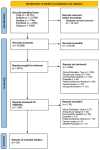Normalising the Implementation of Pharmacogenomic (PGx) Testing in Adult Mental Health Settings: A Theory-Based Systematic Review
- PMID: 39452539
- PMCID: PMC11508855
- DOI: 10.3390/jpm14101032
Normalising the Implementation of Pharmacogenomic (PGx) Testing in Adult Mental Health Settings: A Theory-Based Systematic Review
Abstract
Pharmacogenomic (PGx) testing can help personalise psychiatric prescribing and improve on the currently adopted trial-and-error prescribing approach. However, widespread implementation is yet to occur. Understanding factors influencing implementation is pertinent to the psychiatric PGx field. Normalisation Process Theory (NPT) seeks to understand the work involved during intervention implementation and is used by this review (PROSPERO: CRD42023399926) to explore factors influencing PGx implementation in psychiatry. Four databases were systematically searched for relevant records and assessed for eligibility following PRISMA guidance. The QuADS tool was applied during quality assessment of included records. Using an abductive approach to codebook thematic analysis, barrier and facilitator themes were developed using NPT as a theoretical framework. Twenty-nine records were included in the data synthesis. Key barrier themes included a PGx knowledge gap, a lack of consensus in policy and guidance, and uncertainty towards the use of PGx. Facilitator themes included an interest in PGx use as a new and improved approach to prescribing, a desire for a multidisciplinary approach to PGx implementation, and the importance of fostering a climate for PGx implementation. Using NPT, this novel review systematically summarises the literature in the psychiatric PGx implementation field. The findings highlight a need to develop national policies on using PGx, and an education and training workforce plan for mental health professionals. By understanding factors influencing implementation, the findings help to address the psychiatric PGx implementation gap. This helps move clinical practice closer towards a personalised psychotropic prescribing approach and associated improvements in patient outcomes. Future policy and research should focus on the appraisal of PGx implementation in psychiatry and the role of pharmacists in PGx service design, implementation, and delivery.
Keywords: PGx testing; implementation science; mental health; personalised medicine; personalised prescribing; pharmacogenetics; pharmacogenomics; precision medicine; psychiatry; systematic review.
Conflict of interest statement
The authors declare no conflicts of interest.
Figures



References
-
- GBD 2019 Mental Disorders Collaborators Global, regional, and national burden of 12 mental disorders in 204 countries and territories, 1990–2019: A systematic analysis for the Global Burden of Disease Study 2019. Lancet Psychiatry. 2022;9:137–150. doi: 10.1016/S2215-0366(21)00395-3. - DOI - PMC - PubMed
-
- Buhagiar K., Ghafouri M., Dey M. Oral antipsychotic prescribing and association with neighbourhood-level socioeconomic status: Analysis of time trend of routine primary care data in England, 2011–2016. Soc. Psychiatry Psychiatr. Epidemiol. 2020;55:165–173. doi: 10.1007/s00127-019-01793-9. - DOI - PubMed
-
- Leucht S., Schneider-Thoma J., Burschinski A., Peter N., Wang D., Dong S., Huhn M., Nikolakopoulou A., Salanti G., Davis J.M. Long-term efficacy of antipsychotic drugs in initially acutely ill adults with schizophrenia: Systematic review and network meta-analysis. World Psychiatry. 2023;22:315–324. doi: 10.1002/wps.21089. - DOI - PMC - PubMed
Publication types
Grants and funding
LinkOut - more resources
Full Text Sources
Medical
Miscellaneous

